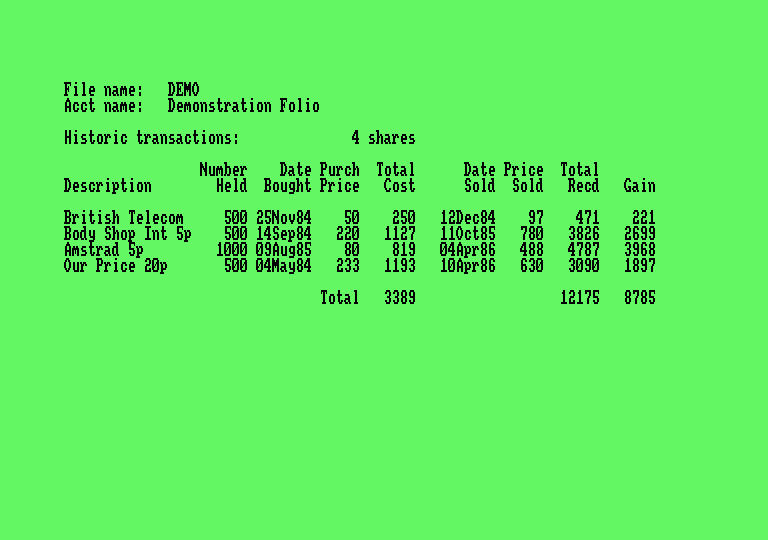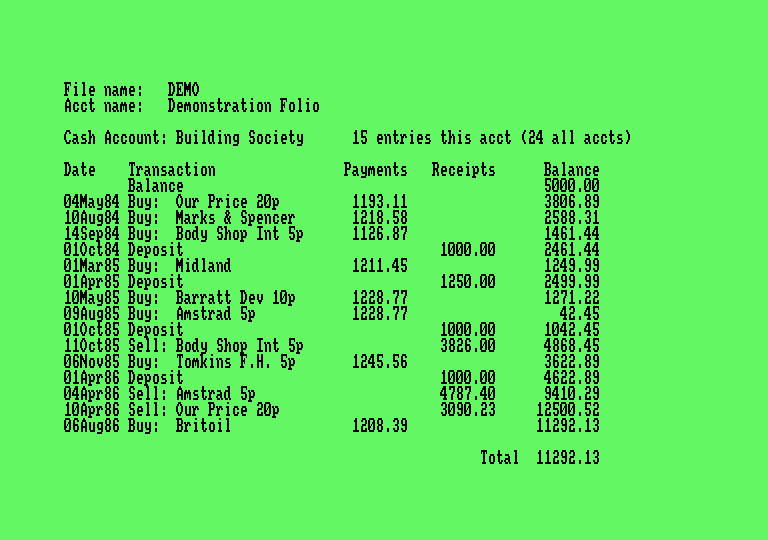There are four main types of business software. These are the word processor. the spreadsheet, the database and the accounts package. Now for something different: Stockmarket from Meridian Software, which is a cunning mixture of the last three breeds of software, plus a little extra. Stockmarket is a sophisticated program designed to record your own personal folio of stocks, shares, government bonds, unit trusts, and just about anything else. It can also plot the rise and fall of up to twelve share prices (titles) at once over a five year period. Admittedly in the light of the current financial chaos it may well be of purely academic use... it's not for me to comment further on this, though. Anyway, Stockmarket is split down the middle. Once you have loaded in a data file - which must be on a separate disk, except to start with - you can select either the accounts program or the the price recorder.  
A word about the style of the program. It's menu driven, but roughly 95 percent of your entry can be selected using the cursor keys alone. This makes for quick, error free input Three levels of menu are provided; these are main, option and question Generally, to go through a particular process takes more steps, but the steps are still simple. There's also a panic button - hit the close square bracket to return to a former menu. From the main menu you can access the following: - Update this allows access to share prices, present yields on shares and also P/E ratios, which can be left to be recalculated by the computer
- List Account: depending on whether you want to see the results on your screen or printer, this lists either your current folio, your historic folio - where every transaction is taken into account, on shares that were sold long ago - your present dividend payments, and any cash accounts you may have set up. The program can also record your method of payment; Access or cheque, that is.
- Buy and Sell: apart from the obvious, this enables you to edit sales and purchases, merge two share blocks together (if you increased your stake in a company) and delete a share block, which isn't a smart inclusion by any stretch of the imagination
- Dividends: these can be entered and edited if incorrect.
- Cash Transactions: from here, you can manipulate your various cash accounts. Access card, bank account, post office etc
- Housekeeping this lets you change the VAT and stamp duty, as well as indicating a printer on-line or changing the screen colours. You can also turn off the default values of the various menus.
- Deal Costs yes, stockbrokers make money on deals too. The program needs to know how much they charge for handling a particular share
City slickerRight, now for some raw info. Accounts can handle up to 50 share blocks per folio, and can take scrips, rights and part paid shares into account. It is one smart cookie. The prices program is designed to be able to make a study of various companies'share prices Up to twelve different titles can be compared. and up to 260 dates can be stored, giving you five years storage at one week intervals
From its main menu you can get to: - Enter/Edit Prices: this is the main entry point for share prices. You can type in the date and price, and amending them is very easy.
- Enter/Edit Titles enter and amend the actual share titles, for instance, "AMSTRAD 5P" The price ceiling - which can be 64 , 640 , 6400 or 64000 - may also be edited.
- List Prices: gives a copy of all the prices and dates entered so far. and which title they belong to.
- Prices you can select which title you want a list of prices and dates for
- Plot Prices: the big one! Once you have entered your list of prices and dates for a particular title, the computer will print a pretty graph. You can select either logarithmic or linear scales - its best to go for log. since any big gains at high prices are in proportion. You can also have an average drawn on the graph, and a hard copy produced
- Adjustments: by use of this option, you can input scrip (which is a free issue of shares to existing shareholders to stop share prices becoming excessively high), rights (issue of new shares to existing shareholders to raise capital) and part paid issues. You can also add a multiplier to prices.
- Housekeeping very similar to the accounts program housekeeping
- Save and Exit: saves your particular database to disk.
- Cont/Restart/Stop you can continue with the pricing program, go to the accounts program or bomb out to Amsdos.
All the on-screen presentation is in 80 column mode and has a straightforward, no-nonsense look about it The program has a professional feel about it. Unfortunately it is let down by a few fairly minor problems. The program appears to me to be written totally in Basic. The fact is almost invisible, except that if you try to print without having a printer, the program locks up - the sort of thing a jumpblock call could have gotten round. Also, the program has no in-built copy routine, you will have to resort either to Tas-copy or Utopia.The manual takes you through the steps of the program quite gently. but doesn't explain a lot You can spend a long time before you understand everything in it. Personally. I put this down to complexity of the program subject rather than the manual being badly written On the other hand, a complete novice at computing might have a lot of trouble getting Stockmarket to behave. I think that Stockmarket's real market is the small scale, long term investor; also the person who wants to learn more about investments. And finally, as an educational tool for letting people indulge in stocks and shares without the danger of losing or the success of gaining. I believe that's where Stockmarket's real potential lies - with the aid of a suitable textbook, of course.
AA
|


